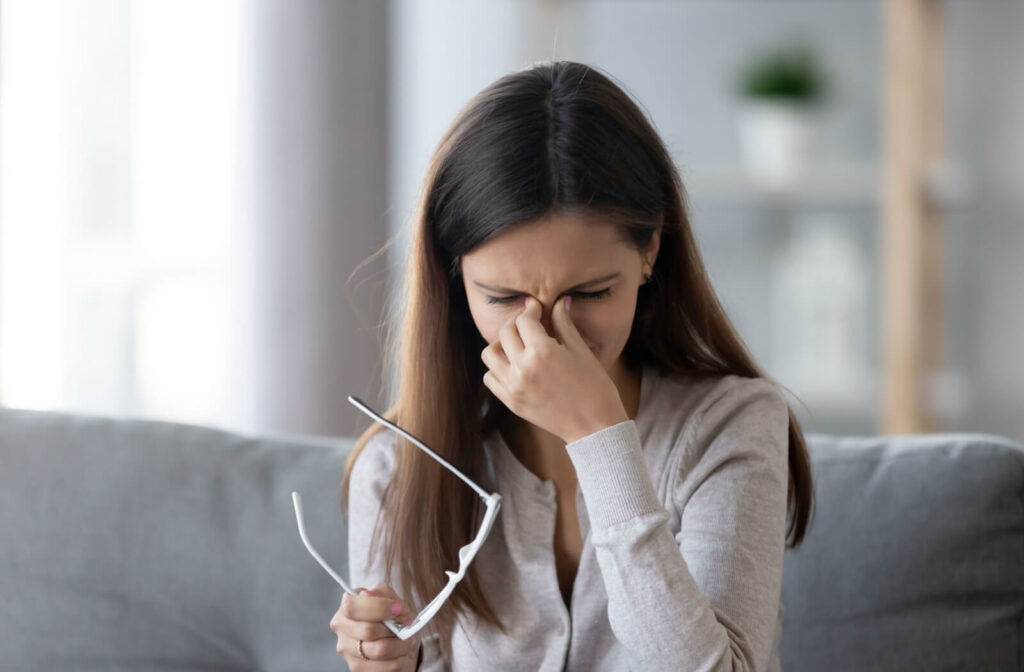If you’ve ever felt a dry, burning, stinging sensation in your eyes, you aren’t alone. Dry eye is a common condition where an imbalance in your tear film leaves your eyes unprotected. This can often develop due to a problem with the meibomian glands in the eyelids.
For mild symptoms, it helps to use a warm compress and eye drops as needed, which can help stimulate your tear film and bring relief. However, if your symptoms persist or are severe, your optometrist can recommend targeted treatments like intense pulsed light, a non-invasive non-surgical approach that can offer lasting relief.
What Are Meibomian Glands?
Your tear film keeps your eyes protected and comfortable. It’s a key part of your visual system and helps the eye flush away bacteria.
To properly function, your tear film needs a healthy balance of 3 layers:
- The inner mucus layer keeps the tear attached to the eye and spread it evenly
- The middle water layer hydrates the eye and flushes away harmful particles
- The outer oily layer prevents the other layers from evaporating too quickly
The oils, also called meibum, are produced by the meibomian glands—the dozens of tiny glands that line your eyelids. If there aren’t enough oils, or if the oils are poor quality, your tears evaporate too quickly, leaving your eyes exposed and vulnerable.
What Is Meibomian Gland Dysfunction?
Meibomian gland dysfunction (MGD) develops when these glands aren’t working as intended. The oils can harden and solidify, which prevents oils from reaching the tear film. Sometimes, a bacterial infection impairs the glands, leading to constant inflammation.
When you have MGD, the glands either produce poor-quality oils or stop producing enough altogether. This leads to a lack of lubrication, often felt as a constant stinging dryness in the eyes.
This can be a chronic or temporary problem. Either way, it’s extremely frustrating. If left untreated, MGD quickly affects your daily comfort and vision, leading to constant discomfort and irritation.
How to Tell If Your Meibomian Glands Are Blocked
If your meibomian glands are blocked, you’ll quickly notice irritation. The most obvious symptom is persistent dryness. It could feel like there’s sand trapped against the surface of your eye.
Other common symptoms of MGD include:
- Persistent irritation or burning sensations in the eyes
- Discomfort that worsens if exposed to dry air
- Dry eyes that don’t improve with over-the-counter artificial tears
- Redness or swelling along the edges of your eyelids
- Blurred vision or extra sensitivity to light
These can range from mild to severe depending on how long your glands have been blocked. If you’re experiencing these symptoms regularly, it’s time to talk to your optometrist and discuss your options.

How to Treat Meibomian Gland Dysfunction
Your optometrist can assess your eye health during a comprehensive eye exam. They can examine your tear film to narrow down the cause of your MGD. Then, they’ll determine a treatment approach that works for your unique situation.
One popular option for unblocking the meibomian glands is an in-office procedure called the intense pulsed light (IPL) treatment. This procedure uses gentle pulses of light to target the meibomian glands and surrounding area to:
- Liquefy blockages in the glands
- Increase tear break-up time
- Reduce inflammation in the eyes
- Improve meibomian gland function
This non-invasive treatment is safe with minimal downtime and long-lasting results. This makes IPL a popular and effective solution for MGD and dry eyes.
Tips for At-Home Relief From Dry Eyes
IPL can be a great way to deal with MGD. It offers quick, lasting relief from the constant irritation.
You can also apply some at-home techniques to supplement professional treatments, support your eye health, and prevent symptoms from recurring:
- Apply a warm compress to your eyelids for a few minutes each day to help soften oil blockages.
- Use eye drops as needed (either prescription or over-the-counter dry eye relief drops).
- Practice regular eyelid massages to stimulate the meibomian glands.
- Stay hydrated by drinking plenty of water throughout the day.
- Maintain good eyelid hygiene by gently cleaning your lids and lashes.
These small steps reduce irritation and inflammation while keeping your eyelids clean. Proper care and hygiene help prevent dryness, irritation, and inflammation. When combined with in-office treatments like IPL, these all promote healthy meibomian glands and a strong, balanced tear film.
Visit Our Team to Find Relief
Dry, irritated eyes can make your everyday life extremely uncomfortable. Blocked meibomian glands can be constantly frustrating, so why deal with it alone? Our team at Vision Care Grayslake can work with you to help you find long-lasting relief.
Book an appointment with us today for a personalized approach to treatment! We’re here to help.




